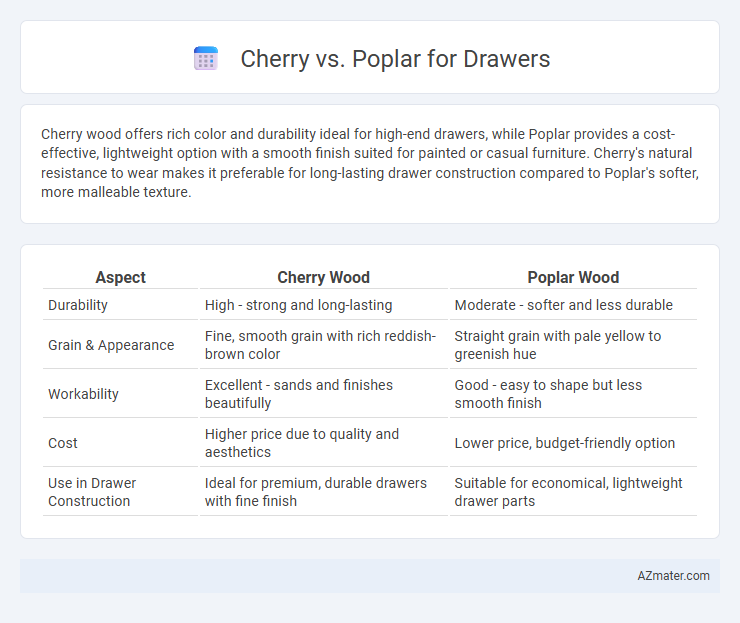Cherry wood offers rich color and durability ideal for high-end drawers, while Poplar provides a cost-effective, lightweight option with a smooth finish suited for painted or casual furniture. Cherry's natural resistance to wear makes it preferable for long-lasting drawer construction compared to Poplar's softer, more malleable texture.
Table of Comparison
| Aspect | Cherry Wood | Poplar Wood |
|---|---|---|
| Durability | High - strong and long-lasting | Moderate - softer and less durable |
| Grain & Appearance | Fine, smooth grain with rich reddish-brown color | Straight grain with pale yellow to greenish hue |
| Workability | Excellent - sands and finishes beautifully | Good - easy to shape but less smooth finish |
| Cost | Higher price due to quality and aesthetics | Lower price, budget-friendly option |
| Use in Drawer Construction | Ideal for premium, durable drawers with fine finish | Suitable for economical, lightweight drawer parts |
Introduction to Cherry and Poplar Wood
Cherry wood features a rich, reddish-brown hue that deepens with age, offering elegance and durability for drawer construction. Poplar wood, known for its light, creamy color and fine, straight grain, provides an affordable and versatile option ideal for painted drawers. Both woods balance workability and strength, but cherry stands out for its natural beauty while poplar excels as a cost-effective, smooth base.
Appearance and Grain Patterns
Cherry wood features a rich, warm reddish-brown hue that deepens with age, offering a smooth and uniform texture ideal for elegant drawer fronts. Poplar wood typically displays a pale cream to light greenish tone with a more varied, straight grain pattern and occasional darker streaks, creating a casual and rustic appearance. Cherry's fine, closed grain contrasts with Poplar's more open and inconsistent grain, influencing the overall aesthetic appeal and finish options for drawer construction.
Durability and Strength Comparison
Cherry wood offers moderate durability with a Janka hardness rating of 950, making it resistant to everyday wear but more prone to dents compared to harder woods. Poplar has a lower Janka hardness of approximately 540, indicating it is softer and less durable for high-impact drawer use. For drawer construction requiring greater strength and longevity, cherry is generally preferred over poplar due to its superior hardness and resistance to damage.
Workability and Ease of Machining
Cherry wood offers excellent workability with its fine, straight grain and uniform texture, making it easy to machine and shape for drawer construction. Poplar is also highly machinable due to its softness and consistent grain, but it may require more careful handling to avoid dents and tear-out during cutting. Both woods perform well in terms of ease of machining, with cherry providing a smoother finish and poplar offering more cost-effective versatility.
Cost and Affordability
Cherry wood generally commands a higher price compared to poplar due to its rich color, durability, and premium quality, making it a more expensive choice for drawers. Poplar is more affordable and widely available, offering a cost-effective option with decent strength, albeit less luxurious appearance and finish than cherry. For budget-conscious buyers, poplar provides greater affordability without sacrificing basic functionality, while cherry suits those prioritizing long-term value and aesthetic appeal despite the higher investment.
Weight and Density Differences
Cherry wood has a density of approximately 35-40 lbs/ft3, making it moderately heavy and durable for drawer construction. Poplar wood is lighter, with a density around 22-28 lbs/ft3, which results in easier handling but less rigidity compared to cherry. The higher density of cherry contributes to greater strength and resistance to wear, while poplar's lower weight can be advantageous for lightweight furniture designs.
Finishing and Staining Qualities
Cherry wood offers a smooth, fine grain that absorbs stains uniformly, resulting in a rich, warm finish ideal for elegant drawers. Poplar has a more porous texture and may blotch if not properly sealed before staining, often requiring a pre-conditioner for an even color application. Both woods take finishes well, but cherry's natural reddish-brown hues deepen beautifully with age, while poplar benefits from stains that mimic more expensive hardwoods.
Environmental Impact and Sustainability
Cherry wood is moderately sustainable due to its slower growth rate and limited regional availability, which can lead to higher environmental impact when harvested unsustainably. Poplar, a fast-growing hardwood, offers a more eco-friendly option as it regenerates quickly and absorbs more CO2 per acre, making it a better choice for environmentally conscious drawer manufacturing. Choosing poplar reduces deforestation pressure and supports sustainable forestry practices compared to cherry.
Best Uses for Cherry and Poplar in Drawers
Cherry wood offers rich color and fine grain, making it ideal for high-end drawers that benefit from durability and elegant finishes. Poplar is a cost-effective choice, well-suited for painted drawer fronts and interior drawer components due to its smooth texture and ease of workability. Both woods provide sturdy construction, but cherry excels in visible, premium applications while poplar suits budget-friendly and painted drawer projects.
Final Verdict: Which Wood is Better for Drawers?
Cherry wood offers rich color and smooth grain ideal for high-end drawers emphasizing durability and aesthetic appeal, while poplar provides a more affordable, lightweight option with good stability but lacks the same luxurious finish. For drawers requiring long-term wear resistance and refined appearance, cherry outperforms poplar due to its hardness and natural luster. Poplar suits budget-conscious projects or painted finishes, but cherry remains the superior choice for premium drawer construction.

Infographic: Cherry vs Poplar for Drawer
 azmater.com
azmater.com